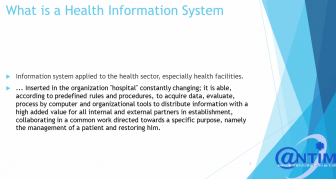Mar 13, 2015
Zambia mHealth Country Feasibility Report
A series of 10 reports for Sub-Saharan Africa. Each report turns a spotlight on the in-country mobile landscape and health burden, in terms of nutrition and maternal and child health, and then assesses the potential for mNutrition services to contribute to public health needs.
Feb 12, 2015
BLN Webinar: Successful Implementation of a Health Information Software
The Better Immunization Data Learning Network (BLN) recently held a webinar entitled Successful implementation of a Health information Software. In this webinar, the speakers shared Mali’ experience implementing health information software. The presentation took the audience through: the software identification process, including identifying and involving stakeholders and effective communication; key implementation steps; and software deployment and related activities.
Feb 12, 2015
mHealth Country Feasibility Report: Tanzania 2015
The Tanzania mHealth Country Feasibility Report is the fourth in a series of 10 reports for Sub-Saharan Africa (Cote D'Ivoire, Ghana, Kenya, Malawi, Mozambique, Nigeria, Rwanda, Tanzania, Uganda and Zambia). Each report turns a spotlight on the in-country mobile landscape and health burden, in terms of nutrition and maternal and child health, and then assesses the potential for mHealth services to contribute to public health needs. This series of reports is central to the aims of the GSMA Mobile for Development mHealth programme - to promote replication and the integration of mobile into health.Aug 27, 2012
Nigeria Immunization Fact Sheet
EPI Plan, Tools, USAID
Nigeria
Download File: vnd.openxmlformats-officedocument.wordprocessingml.document (3.9 MB)
Feb 5, 2015
The BID Learning Network Grant Program
The BID Learning Network is structured with a small grant program to facilitate the advancement of Design country specific goals that are aligned with the BID Initiative priorities. The objective of the program ties into the overall goals of the BLN, including to experiment with projects in countries to determine their applicability; and then use this experience to inform national and global decision-making.
Read the full guidelines in how propospective applicants from Design countries can access these funds in the Grant Program section.
Aug 21, 2012
Liberia Routine Immunization Overview
The DHS conducted in 2007 pointed to coverage rates in Liberia that were significantly lower than official country reports. Despite an increasing trend between 2004 and 2009, WHO/UNICEF estimates illustrate a sharp decrease in coverage over the last two years. In 2011, Liberia’s immunization program failed to reach 39% (or 56,160) of its target population of children under one year of age with even a first dose of the DTP vaccine. Twelve percent of the children who began the DTP vaccination series did not complete it (drop out rate between DTP1 and DTP3), as shown in the graph below. Drop-out rates that are higher than 10% typically indicate problems with how immunization services are being delivered, perceived (e.g. friendly and reliable services) and used. The population’s use of routine immunization services is determined by the availability of, access to, demand for, and acceptance of those services.Download File: vnd.openxmlformats-officedocument.wordprocessingml.document (4.2 MB)
Aug 6, 2012
Kenya Routine Immunization Overview
Kenya’s national immunization program was one of the most successful in East Africa in the 1990s. In the last ten years, Kenya’s immunization coverage for DTP3 has averaged between 73% and 88%. The drop-out rate nationally was reported at 7% in 2009 (see graph below). Coverage has varied, however, between provinces–with some reporting DTP3 below 70% and with DPT1-DPT3 drop-out rates above 10%. In 2008, a post-election political crisis destabilized the country, particularly in Western, Nyanza and Rift Valley provinces. This resulted in interruption of health services, including vaccination, during that year. There were also vaccine stock-outs in 2008 and the first quarter of 2009. Additionally, the division of districts and creation of new districts (from 78 to 254) has resulted in problems with denominator calculations and difficulty in ensuring fully functioning District Health Management Teams and services in many of the new districts. The recent creation of two separate health ministries with split program functions has also resulted in managerial and financial complications for preventive services like immunization.Download File: vnd.openxmlformats-officedocument.wordprocessingml.document (4.3 MB)
Oct 11, 2012
JLN Information Technology Track: Collaborating Across Countries for Health Insurance Information Systems
Peer Learning, Software, Tools
Global
Download File: vnd.openxmlformats-officedocument.presentationml.presentation (2.6 MB)
Dec 10, 2012
Improving data quality in The African Region
Data Warehouse, Software, Standards, Tools, WHO
Global
- Data quality is one of the 4 IVD priority in AFRO
- Existence of robust DM system at different level
- There is more interest on data quality than ever (Opportunity)
- Good data = good decision, wrong data = wrong decision
- Need data to monitor goals at all levels (Country, Region, Global)
- Data management has not enjoyed deserved recognition from EPI Manager on staff allocation (skills)
- Recommendations from TFI as well as EPI managers’ meetings
May 25, 2012
Decade of Vaccines Fact Sheet
GVAP (Global Vaccine Action Plan), Tools, WHO
Global
Download File: vnd.openxmlformats-officedocument.wordprocessingml.document (45 KB)
Jump in. Expand your knowledge.
Events
No upcoming events.
